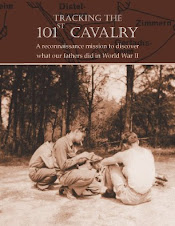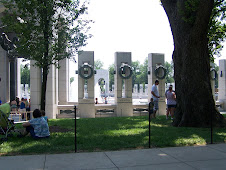When my son Ted and I visited Murnau am Staffelsee in March 2006,
snow still covered the ground and ice rimmed the lake. We walked on a few of
trails outside of town and spent the late afternoon sitting at a chilly
sidewalk cafe, eating cake, and people watching.
We were there because Troop B, 116th Squadron, my father's troop in the 101st Cavalry, had traveled through Murnau on their way to Austria on April 29, 1945, one day before Hitler committed suicide and less than
a week before the war ended. Around 3:00 p.m. that day, they passed Oflag
VII-A, a camp imprisoning thousands of Polish officers. As the Americans passed the camp, they were approached by a group of SS coming from the opposite direction. The two groups met right
outside the camp gate. After a short exchange of fire, two members of the SS
were killed and one prisoner who was struck by a stray bullet. According to the
records of the 116th squadron, the first of the Americans to enter the camp was Corporal
Richard Pawlowski of Chicago
 |
A U.S. helmet found in the region.
Photo used with permission
of Martin Lohmann
|
Ted and I couldn't visit the camp, now an active German army base, nor did we see any signs of World War II when we were
there. But that is only because we didn't know Martin Lohmann at that time. For
several years, he and students in his history class have been
collecting information about the camp, as well as photos and other artifacts. Martin
is currently writing a book about Oflag VII-A and organizing a 70th anniversary
celebration for April 24, 2015. The anniversary will include an opportunity to tour the camp, some of which is much the same as it was in 1945.
It's not the only event he has organized lately. From February 10 to 23 this year, he and his students held an
exhibition in the local museum about the end of the war in their area. It included several
rooms with military artifacts, either found in the ground or given to the
exhibition by veterans. Some of the artifacts included posters, maps, photos, war
diaries, and a completely rebuilt air-raid shelter with sounds of an actual
bomb raid. One room was set aside for information about Oflag VII-A. More than
1,000 visitors came to see the exhibit.
As he prepares for the 70th anniversary celebration, Martin is seeking more artifacts, as well as first-person accounts from the camp and its liberation. If you have anything you might be willing to share with him to help complete the story of Oflag VII-A, you may email him directly.












